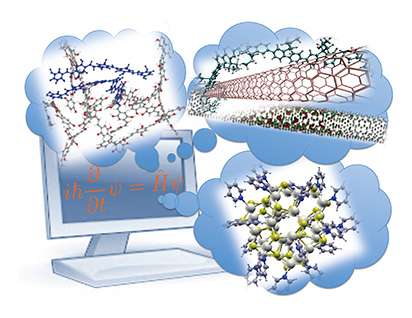Modeling sunlight harvesting in nanostructures

To create the next generation of solar panels and other light-driven devices, scientists must model how complex interactions occur. Modeling across different scales, from individual atoms to very large systems with thousands of atoms, provides needed insights. In a review article in Chemical Reviews, a team of scientists assessed the state of the art for calculations used to model electronic states in exceedingly thin films. The calculations and resulting models shed new light on relevant predicted electronic and optical properties and light-driven dynamic processes. For example, scientists developed models that led to rational design principles for better solar panels and other solar energy conversion technologies.
This review article provides a one-stop shop for understanding the state of the science and highlights upcoming computational challenges, such as simulating large numbers of atoms and phenomena that cross scales, such as interactions at the atomic scale that influence far larger areas.
Scientists reviewed electronic structure calculations of light-driven processes in organic and semiconductor nanostructures. They also reviewed how these calculations have furthered our understanding of the optical properties and excitation dynamics of the nanostructures. In the review, these nanostructures range from nanocrystals called quantum dots with zero dimensionality to nanotubes and isolated polymer chains of organic semiconductors that are quasi–one-dimensional materials. The size, shape, and topology of these nanostructures control their properties. The dimensionality defines the "quantum confinement" in these nanostructures and affects the electronic structure and "photophysics."
For example, the size of the quantum dot determines the confinement of the electronic excitation, i.e., the electronic band gap strongly depends on the size of the quantum dot. In addition, factors ranging from surface chemistry to structural disorder affect electronic properties as well as light harvesting and carrier transport in solar energy conversion devices. The scientists highlighted how theory, modeling, and simulation can complement experiments to fully understand and exploit electronic and structural properties. Nevertheless, the authors identified challenges ranging from the computationally unmanageable number of atoms in large-scale nanostructures to the complexity and multiscale nature of important optical phenomena that must be overcome.
More information: Svetlana Kilina et al. Light-Driven and Phonon-Assisted Dynamics in Organic and Semiconductor Nanostructures, Chemical Reviews (2015). DOI: 10.1021/acs.chemrev.5b00012
Svetlana Kilina et al. Conditions for Directional Charge Transfer in CdSe Quantum Dots Functionalized by Ru(II) Polypyridine Complexes, The Journal of Physical Chemistry Letters (2014). DOI: 10.1021/jz502017u
Mary M. Hedrick et al. First-Principles Studies of the Ground- and Excited-State Properties of Quantum Dots Functionalized by Ru(II)–Polybipyridine, The Journal of Physical Chemistry C (2013). DOI: 10.1021/jp403819h
Journal information: Chemical Reviews , Journal of Physical Chemistry Letters , Journal of Physical Chemistry C
Provided by US Department of Energy





















